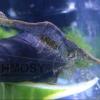By Fishmosy (Dr. Benjamin Mos) and Northboy
Habitat and Water Conditions
Riffles are so named because they are found in riffles, shallow fast flowing sections of creeks. They occur in easterly flowing creeks from Northern Queensland down to Victoria, Australia. Two famous collecting areas are the Atherton Tablelands in QLD and Never Never Creek, near Bellingen NSW.
Riffles can grow to over 6cm, reports of 8cm is not uncommon. However, these shrimp change sex at around 3.5-4cm from males to females. If you want to breed these shrimp, ensure you have both size ranges.
Breeding
Breeding riffles is fairly easy. The entire lifecycle is carried out in freshwater. BBS or brine shrimp nauplii are a great conditioning food for adults. Eggs are carried by the female and hatch out as miniature adults. Shrimplets take the same food as adults, including brine shrimp nauplii and flake food, as well as grazing on algae/biofilm.
Food
One of the greatest attributes of these shrimp is watching them use their filter feeding feet to catch food items wafting in the current. They may even learn 'feeding time' and take up positions in the tank to grab food drifting by. Riffles also become less timid over time, and are often seen out and about in the aquarium.
Adults are also reported to feed on BBA and cyanobacteria (BGA).
General Notes
Riffles are adaptable to most aquarium conditions as long as extremes are avoided, but require highly oxygenated water, temperatures not exceeding 27 degrees C for long periods of time and are sensitive to phosphates and CO2. Stressed riffles will change colour to bright red or dark blue. However, their natural colouration is highly variable, greens to blues, black and white, and stripes, so colour changes aren't always indicative of problems. Riffles also seem to like hanging out on timber.
Warning: These shrimp can and do climb, so keep tight-fitting lids on your tanks.
You can keep riffles with fish as long as they can't fit in the fishes mouths, although the fish may hassle the shrimp. However, riffles can turn the tables and eat small fry.
Further Information
Riffle Shrimp from the Atherton Tablelands by Bob Kroll in AquariumKeeper Australia Vol 1, Iss 2 (Out of print)



Below is some water parameters from a creek where riffles are found on the Mid North Coast of NSW, Australia, near Coffs Harbour.
Time of year: Late Spring (Nov, 2012).
Water parameters were as follows:
Temp - 22.5*C
Ammonia - undetectable
Nitrite - undetectable
Nitrate Undetectable
pH 6.8-7.0
Hardness - KH below 10mg/L, - GH 20-40mg/L
Ca - less than 20mg/L
PO4 - undetectable
Other than temperature, these parameters were measured using a Hagen Nutrafin Master test kit.
Here are some pictures from the area.
This is a typical area where riffles can be found, if you are looking in the shallow pool at the bottom of the picture, you won't find them. Look for the riffles like mid photo (enlarged in the second pic), no matter how shallow it may appear, riffles should be there.


Male and female riffles often congregate in different areas. Here is an area where I found only females. Notice the width of the riffle and the presence of lots of habitat structure (rocks).

Here is a place that was dominated by males. Notice that there are very few points to access upstream areas. The males were quite dense directly beneath the overflows of the concrete river crossing. Up to 6 riffles under each rock was not uncommon. My theory is that males congregate at these 'choke points' to access females (for breeding) which travel through to access upstream areas. This point was 50m or so downstream of the female habitat. Alternatively females may seek out these areas at moulting time (I have found recently moulted females in these areas).
Another interesting point as to why riffles might not occur in shallow pools was because of the amount of eels in this creek. There was literally one per pool. The large pool above the creek crossing contained one that must have close to 1metre in length.

Finally another interesting factor I've found in finding riffles is that they seem to prefer the darker rocks (possibly granite, but I'm no geologist) indicated in this picture by blue dots, avoiding the lighter coloured rocks (red dots). In areas where this light coloured rock dominate, I have found no riffles at all, even if it seems like optimal habitat. Maybe it is a camoflague preference?

Hope you have found this interesting and informative. Best of luck with keeping your riffles.


